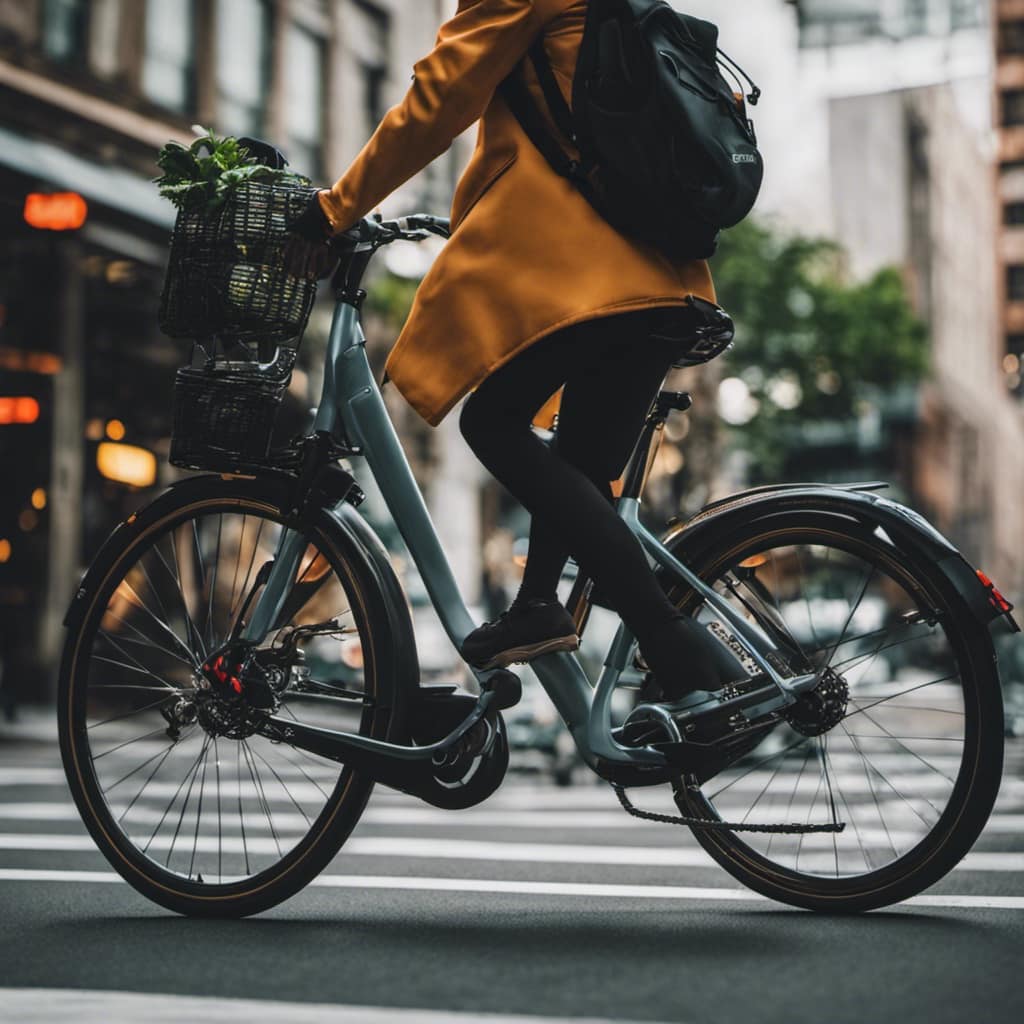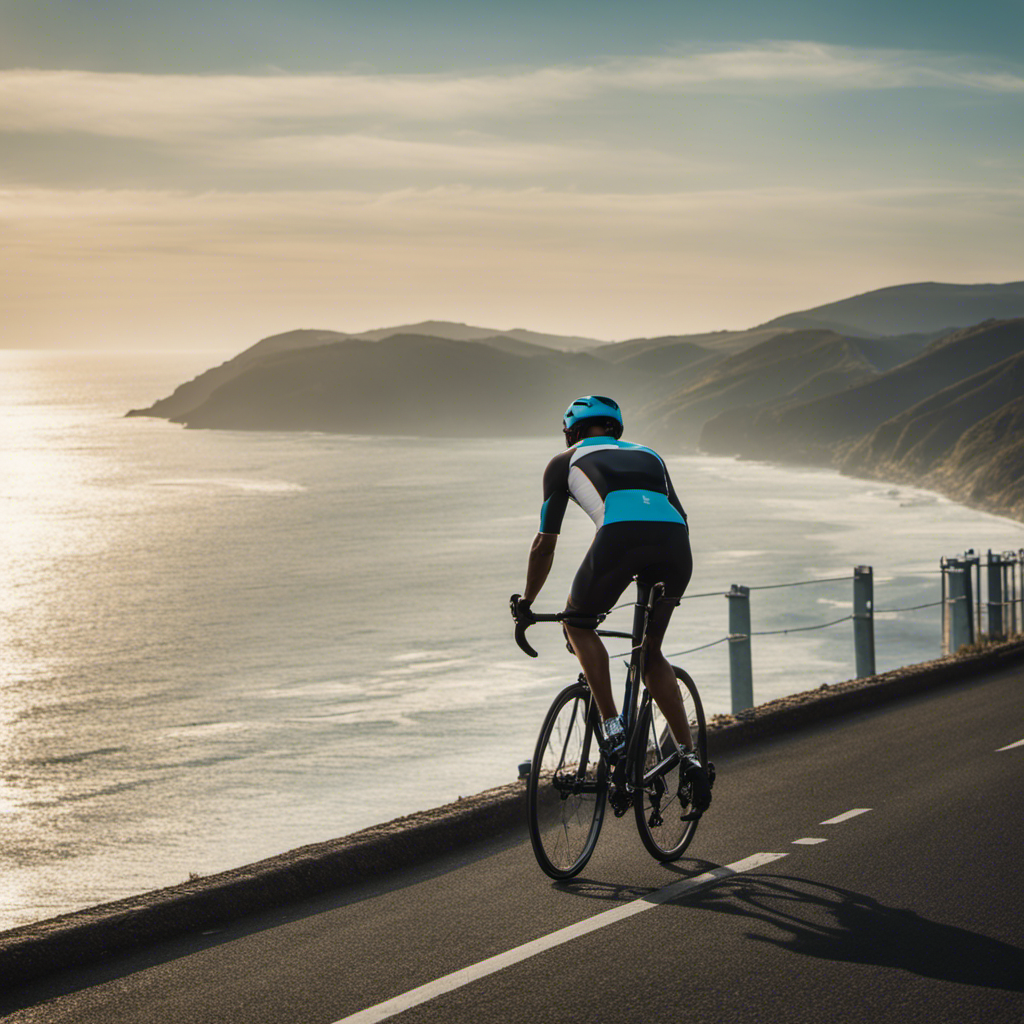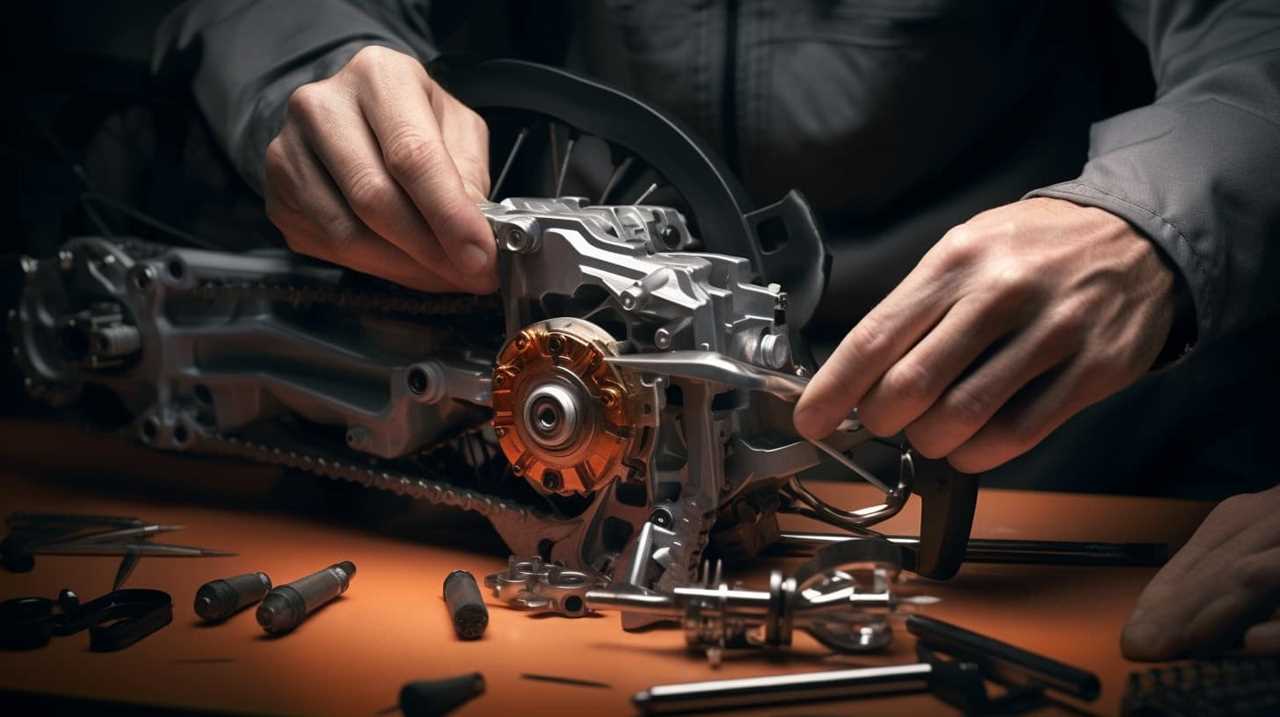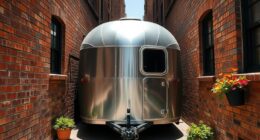Are you ready to unleash the full potential of your hybrid bike?
In this article, we’ll show you how to break free from limitations and soar to new speeds.
With our expert tips and techniques, you’ll be able to boost your cycling speed and reach new heights of freedom on your hybrid bike.
So, get ready to unlock your potential and experience the exhilaration of a faster, more exhilarating ride.

Let’s hit the road together and leave the competition in the dust.
Key Takeaways
- Assess and analyze your current speed and riding technique
- Set realistic goals for speed improvement and break them down into smaller targets
- Utilize measurement strategies such as tracking average speed and distance covered, and monitoring heart rate for progress assessment
- Optimize your training routine, bike fit, and gear for enhanced speed and performance
Assessing Your Current Speed
Let’s start by gauging our current speed on the hybrid bike to determine our starting point for improvement. Setting speed targets is crucial to track progress and push ourselves towards higher performance.
To achieve this, we need to analyze our riding technique. Look closely at how you pedal, shift gears, and maintain a steady cadence. Are you using your gears efficiently? Are you maximizing your power output? Pay attention to your body position and posture too. Are you maintaining an aerodynamic shape?
Evaluating these factors will help us identify areas for improvement and develop a strategy to increase our speed. Remember, small adjustments can lead to significant gains.

Setting Realistic Goals
When it comes to setting realistic goals for boosting our cycling speed on a hybrid bike, there are a few key points to consider.
First, we need to develop effective goal-setting strategies that are specific, measurable, attainable, relevant, and time-bound. This will help us stay focused and motivated throughout our training.
Second, it’s important to measure our progress regularly using tools like GPS trackers or cycling apps to track our speed, distance, and time. This will allow us to see how far we’ve come and make adjustments if needed.
Lastly, we must be prepared to overcome obstacles and setbacks along the way, whether it’s a plateau in our progress or unexpected challenges. By staying persistent and adapting our approach, we can continue to move towards our goals and unlock our full potential.

Goal-Setting Strategies
We can achieve our cycling goals by setting realistic targets and working towards them.
Goal setting strategies play a crucial role in helping us unlock our potential on a hybrid bike. One effective strategy is to start by identifying specific and measurable goals that are attainable within a certain timeframe. This helps us stay focused and motivated throughout our cycling journey.
Additionally, utilizing mental strategies can greatly enhance our performance. Visualizing ourselves reaching our goals and overcoming challenges can boost our confidence and mental strength.
It’s also important to break down our goals into smaller, manageable steps, allowing us to track our progress and celebrate each milestone along the way.

Measuring Progress Effectively
To accurately track our progress and set achievable goals, it’s important to use concrete metrics and coordinate our efforts. When it comes to measuring progress effectively, we need to optimize our training routine and focus on key indicators.
One effective metric is tracking our average speed during rides. By recording our average speed over time, we can see if we’re improving and identify areas for further development.
Another metric to consider is the distance covered within a set time frame. This can help us gauge our endurance and monitor our ability to sustain speed over longer distances.
Additionally, heart rate monitoring can provide valuable insights into our cardiovascular fitness and help us understand our exertion levels during training.

By using these metrics and regularly assessing our progress, we can set realistic goals and make informed adjustments to our training routine.
With a clear understanding of our progress, we can now move on to discussing how to overcome obstacles and setbacks.
Overcoming Obstacles and Setbacks
As we encounter obstacles and setbacks on our cycling journey, it’s crucial that we set realistic goals to keep ourselves motivated and on track. Overcoming mental blocks and staying motivated can be challenging, but with the right approach, we can push through and achieve our desired results.
Here are three strategies to help us overcome obstacles and setbacks:

-
Break it down: Instead of focusing on the end goal, break it down into smaller, manageable targets. This way, we can celebrate each milestone and stay motivated along the way.
-
Stay positive: It’s important to maintain a positive mindset and believe in our abilities. Surrounding ourselves with supportive individuals and using positive affirmations can help us overcome self-doubt and stay motivated.
-
Learn from setbacks: Setbacks are inevitable, but they provide valuable learning opportunities. Instead of dwelling on failures, reflect on what went wrong, make necessary adjustments, and use these experiences to grow stronger.
Incorporating Interval Training
Now let’s talk about incorporating interval training into your cycling routine.

Interval training is a highly effective method for improving speed and endurance. By alternating between periods of high-intensity effort and recovery, you can push your body to new limits.
In this section, we’ll explore the benefits of intervals, proper interval techniques, and the recommended frequency of interval sessions.
Benefits of Intervals
We definitely see impressive improvements in our cycling speed when we incorporate interval training into our workouts. Interval training benefits our speed potential in several ways:
-
Increased aerobic capacity: Interval training pushes our bodies to work at a higher intensity, which improves our cardiovascular fitness and increases our lung capacity. This allows us to take in more oxygen and deliver it to our muscles more efficiently, resulting in improved speed and endurance.

-
Enhanced power output: By alternating between high-intensity bursts and recovery periods, interval training helps us develop more power in our leg muscles. This increased power output allows us to generate more force with each pedal stroke, propelling us forward with greater speed.
-
Improved lactate threshold: Interval training helps us push our lactate threshold higher, which is the point at which lactic acid builds up in our muscles. By training at higher intensities, we increase our ability to tolerate and clear lactic acid, delaying fatigue and enabling us to maintain a faster pace for longer.
Incorporating interval training into our cycling routine can have a significant impact on our speed, allowing us to unlock our full potential on a hybrid bike.
Proper Interval Techniques
One key technique to maximize the benefits of interval training is to gradually increase the intensity of our high-intensity intervals over time. This technique allows us to continually challenge our bodies and improve our speed on a hybrid bike.

To implement this method effectively, we can start by performing shorter intervals at a high intensity, such as 30 seconds to 1 minute. As we progress, we can gradually increase the duration of the intervals and the intensity of our efforts. This progressive overload helps to improve our cardiovascular fitness and build endurance.
Additionally, incorporating different types of interval training techniques, such as Tabata intervals or pyramid intervals, can further enhance our speed and performance on a hybrid bike.
The key is to find a balance between pushing ourselves to the limit and allowing enough recovery time to prevent burnout and injury.
Frequency of Interval Sessions
To maximize our cycling speed on a hybrid bike, incorporating interval training into our routine is essential for improving our performance. Interval training involves alternating between periods of high-intensity effort and recovery. When it comes to the frequency of interval sessions, it’s important to find a balance that works for our individual needs and goals.

Here are some key factors to consider:
-
Interval session duration: The duration of each interval session will depend on our fitness level and training goals. Beginners may start with shorter intervals of 30 seconds to 1 minute, while more advanced riders can aim for intervals of 2 to 5 minutes.
-
Best time of day for interval training: The best time to incorporate interval training into our cycling routine is when we feel most energized and focused. This could be in the morning, afternoon, or evening, depending on our personal preferences and schedule.
-
Rest and recovery: It’s important to allow for adequate rest and recovery between interval sessions. This will help prevent overtraining and reduce the risk of injury. Aim for at least 1 to 2 days of rest between intense interval sessions.

Working on Endurance
Our key to improving endurance on a hybrid bike is consistency in our training. Building endurance requires a gradual increase in our cycling distance and duration over time. By pushing ourselves to ride longer distances at a steady pace, we can improve our stamina and overall endurance. It is important to maintain a comfortable cadence and focus on proper breathing techniques. Incorporating interval training into our rides can also help to improve our endurance. This involves alternating between high-intensity bursts and recovery periods. By challenging ourselves with these intervals, we can push our bodies to adapt and improve our cardiovascular fitness. Here is a table to illustrate a sample endurance training plan:
| Week | Training Distance (miles) | Training Duration (hours) |
|---|---|---|
| 1 | 10 | 1 |
| 2 | 12 | 1.5 |
| 3 | 15 | 2 |
| 4 | 18 | 2.5 |
| 5 | 20 | 3 |
Remember to listen to your body and gradually increase the intensity and duration of your rides. With consistent training and a focus on endurance, you will unlock your potential on your hybrid bike.
Ensuring Regular Bike Maintenance
By regularly cleaning and lubricating our bike’s components, we can ensure optimal performance and extend the lifespan of our hybrid bike. Proper bike maintenance is crucial for a smooth and safe riding experience. Here are some essential bike maintenance tips to keep in mind:
-
Clean your bike regularly: Use a mild detergent and water to clean the frame, wheels, and drivetrain. This will remove dirt, grime, and debris that can cause wear and tear.

-
Lubricate moving parts: Apply lubricant to the chain, gears, and pedals to reduce friction and ensure smooth operation. This will also prevent rust and corrosion.
-
Check tire pressure and condition: Maintain the recommended tire pressure to improve efficiency and prevent flats. Inspect the tires for any signs of wear or damage and replace them if necessary.
Regular bike maintenance isn’t only important for performance but also for your safety. Taking the time to care for your hybrid bike will ensure a more enjoyable and liberating cycling experience.
Prioritizing Recovery
After a challenging ride, it’s important for us to prioritize recovery in order to optimize our cycling performance. Implementing effective recovery strategies and understanding the importance of rest can significantly enhance our overall cycling experience.

One key strategy is to engage in active recovery, such as light cycling or stretching, to increase blood flow and reduce muscle soreness. Additionally, incorporating proper nutrition, including adequate protein and carbohydrates, can aid in muscle repair and replenish depleted energy stores.
It’s also crucial to prioritize quality sleep, as this is when our bodies repair and regenerate. By allowing ourselves ample time to rest and recover, we can prevent burnout, reduce the risk of injuries, and ultimately improve our cycling speed and endurance.
Transitioning into the subsequent section about ‘maintaining hydration’, it’s equally important to hydrate properly during and after our rides to support optimal recovery.
Maintaining Hydration
During long rides, it’s essential to stay hydrated and drink plenty of fluids to maintain optimal cycling performance. Hydration strategies can make a significant difference in your ability to endure and perform at your best. Here are three tips to help you maintain hydration and stay motivated on your rides:

-
Drink water regularly: Sip on water every 15-20 minutes, even if you don’t feel thirsty. This will help prevent dehydration and keep your body functioning properly.
-
Use electrolyte drinks: Electrolyte drinks can replenish the minerals lost through sweat, helping to maintain your body’s fluid balance. Look for drinks that contain sodium, potassium, and magnesium.
-
Consider a hydration pack: A hydration pack is a convenient way to carry water with you on long rides. It allows you to drink without having to stop or slow down, helping you stay hydrated and focused on the road.
Considering Upgrading Cycling Gear
When it comes to considering upgrading our cycling gear, there are a few important factors to consider.

Firstly, we need to weigh the pros and cons of sticking with our hybrid bike or investing in a road bike.
Secondly, we need to think about the cost implications of upgrading our gear and whether it fits within our budget.
Lastly, we should explore the potential benefits of new gear, such as improved speed, comfort, and efficiency.
Hybrid Vs. Road Bike
We have three key factors to consider when deciding between a hybrid bike and a road bike for upgrading our cycling gear.

-
Endurance: Road bikes are designed for speed and efficiency, making them ideal for long-distance rides. They have a lightweight frame, narrow tires, and a more aggressive riding position, allowing for better aerodynamics. On the other hand, hybrid bikes offer a more upright riding position, wider tires, and a more comfortable feel, making them suitable for shorter rides and rough terrains.
-
Versatility: Hybrid bikes excel in versatility as they can handle both paved roads and off-road trails. They come with features such as wider tires, front suspension, and disc brakes, enabling riders to navigate various terrains with ease. Road bikes, however, are specifically designed for smooth pavement and may not perform as well on uneven surfaces.
-
Speed: Road bikes are built for speed, with lightweight frames, narrow tires, and aerodynamic designs. They allow for efficient power transfer and minimize wind resistance, resulting in faster speeds. Hybrid bikes, while not as fast as road bikes, offer a good balance between speed and comfort, making them a suitable choice for riders who prioritize a smooth and enjoyable ride.
Considering the benefits of road biking and the advantages of hybrid bikes, it’s important to assess our individual preferences, riding style, and intended use to make an informed decision when upgrading our cycling gear.

Cost of Upgrading
For our cycling gear upgrade, we need to consider both the cost of upgrading and the benefits it will bring to our cycling experience. When it comes to upgrading options, there are a variety of choices available, ranging from individual components like tires and pedals to complete groupset upgrades. The cost of upgrading can vary greatly depending on the specific items you choose and the brand you prefer. To help you better understand the budget considerations, here is a table outlining some common cycling gear upgrades and their approximate costs:
| Upgrade | Approximate Cost |
|---|---|
| Upgraded tires | $50-$100 per tire |
| Clipless pedals | $50-$200 |
| Lightweight frame | $500-$2000 |
| Electronic shifting | $1000-$3000 |
| Carbon fiber wheels | $1000-$3000 per pair |
Considering your budget and priorities, you can choose which upgrades are most important to you. Upgrading your cycling gear can provide numerous benefits to your cycling experience, including increased speed, improved comfort, and enhanced performance. So, let’s explore the benefits of new gear in the next section.
Benefits of New Gear?
Upgrading efficiency and enhancing performance are two major benefits of investing in new cycling gear. Here are three reasons why upgrading your gear can make a significant difference in your cycling experience:
-
Improved aerodynamics: Upgrading to sleek and aerodynamic gear, such as aero helmets or aero handlebars, can reduce drag and improve your speed. By minimizing air resistance, you can achieve higher speeds with less effort.

-
Enhanced gear ratios: Upgrading your drivetrain components, such as the cassette or chainrings, can provide smoother gear shifts and allow you to maintain a consistent cadence. This leads to more efficient power transfer and improved overall performance.
-
Lighter weight: Upgrading to lighter gear, like carbon fiber components or lightweight frames, can reduce the overall weight of your bike. This translates to easier acceleration, faster climbs, and less fatigue during long rides.
Training Consistently
To maximize our progress and improve our cycling speed on a hybrid bike, consistency in training is key. By training consistently, we can assess our progress and overcome any setbacks that may come our way.
One effective way to assess our progress is by keeping a training log. This allows us to track our rides, record our distances, and monitor our speed improvements over time. It also helps us identify areas where we may need to focus our training efforts.

Additionally, consistent training helps us overcome setbacks such as fatigue or muscle soreness. By gradually increasing our training load and incorporating rest days into our schedule, we can avoid burnout and allow our bodies to recover properly.
Tracking Progress
We can track our progress by using a cycling app or a GPS device. These tools allow us to assess our progress by providing data on metrics such as distance, speed, and elevation. By analyzing this information, we can gain insights into our performance and identify areas for improvement.
Tracking our progress not only helps us set goals but also allows us to celebrate our achievements and stay motivated. However, it’s important to remember that progress isn’t always linear, and setbacks are a normal part of any journey. When faced with setbacks, we can use them as opportunities for learning and growth. By overcoming setbacks, we become stronger and more resilient cyclists.
Now, let’s explore how optimizing our bike fit can further enhance our cycling experience.

Optimizing Bike Fit
Let’s start by adjusting our bike fit to maximize our comfort and efficiency on the road. Assessing bike fit is crucial in ensuring that our body is properly aligned with the bike.
First, we need to adjust the saddle height. When seated on the bike, our legs should have a slight bend at the bottom of the pedal stroke.
Next, we should adjust the handlebar position. It should be at a comfortable height and distance from the saddle, allowing us to maintain a relaxed and aerodynamic position. Additionally, we can also make small adjustments to the stem length and angle to fine-tune our bike fit.
By adjusting our bike position, we can reduce the risk of discomfort, improve power transfer, and enhance our overall cycling experience.

Now, let’s move on to improving our pedaling technique.
Improving Pedaling Technique
Improving our pedaling technique significantly enhances our cycling performance. To maximize our potential on a hybrid bike, we need to focus on two key areas: correcting posture and increasing cadence. Here’s how to do it:
-
Correcting Posture: Maintaining proper posture while cycling is crucial for efficient pedaling. Keep your back straight, shoulders relaxed, and engage your core muscles. This allows for better power transfer and reduces strain on your body.
-
Increasing Cadence: Cadence refers to the number of revolutions per minute (RPM) of your pedals. Aim for a cadence between 80-100 RPM for optimal efficiency. To increase cadence, focus on spinning the pedals using a smooth and circular motion. This reduces fatigue and allows you to maintain a steady speed.

-
Training Exercises: Incorporate interval training and hill repeats into your cycling routine. These workouts help improve leg strength, endurance, and pedal technique. Practice pedaling drills, such as single-leg pedaling, to improve pedal stroke efficiency.
Implementing Mental Strategies
To enhance our cycling speed on a hybrid bike, it’s important to implement mental strategies that can help us stay focused and motivated throughout our rides.
Improving focus is crucial for achieving peak performance on the bike. One strategy to improve focus is setting clear goals before each ride. By establishing specific targets, such as completing a certain distance or achieving a specific average speed, we can direct our attention towards these objectives and push ourselves to reach them.
Another important mental strategy is building mental resilience. Cycling can be physically demanding, and it’s essential to develop the mental strength to overcome challenges and push through fatigue. Techniques such as positive self-talk, visualization, and mindfulness can help train our minds to stay resilient and focused, allowing us to perform at our best on the bike.

Conclusion
So there you have it, folks. With these simple tips, you’ll be zooming past everyone on your hybrid bike in no time.
It’s almost comical how easily you can unlock your cycling potential. Just remember to assess your current speed, set realistic goals, incorporate interval training, work on endurance, maintain your bike, track your progress, optimize your bike fit, improve your pedaling technique, and implement mental strategies.
Easy, right?
Happy cycling!










